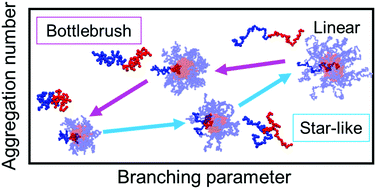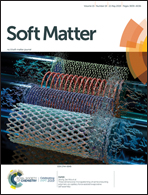Molecular dynamics simulation study of linear, bottlebrush, and star-like amphiphilic block polymer assembly in solution†
Abstract
In this study we investigate the effect of varying branched polymer architectures on the assembly of amphiphilic block polymers in solution using coarse-grained molecular dynamics simulations. We quantify assembly structure (e.g., aggregation number, assembly morphology, and micelle core size) and thermodynamics (e.g., unimer to micelle transition conditions) as a function of increasing solvophobicity of the solvophobic block in the copolymer for three broad categories of polymer architectures: linear, ‘bottlebrush’ (with many short side chains on a long backbone), and ‘star-like’ (with few long side chains on a short backbone). Keeping the total number of coarse-grained beads in each polymer (or polymer molecular weight) constant, as we go from either linear or ‘star-like’ to ‘bottlebrush’ polymer architectures, the micelle aggregation number and micelle core size decrease, and the solvophobicity required for assembly (i.e., transition solvophobicity) increases. This trend is linked to the topological/steric hinderance for making solvophobic bead contacts between neighboring polymers for the ‘bottlebrush’ polymer architecture compared to the linear or ‘star-like’ architectures. We are able to identify some universal trends in assembly by plotting the assembly structure and thermodynamics data as a function of branching parameter defined as the ratio of the branched chain to the linear chain radius of gyration in the unimer state, and the relative lengths of the backbone versus side chain. The results in this paper guide how one could manipulate the amphiphilic block polymer assembly structure and thermodynamics by choosing appropriate polymer architecture, block sequence, and composition.



 Please wait while we load your content...
Please wait while we load your content...